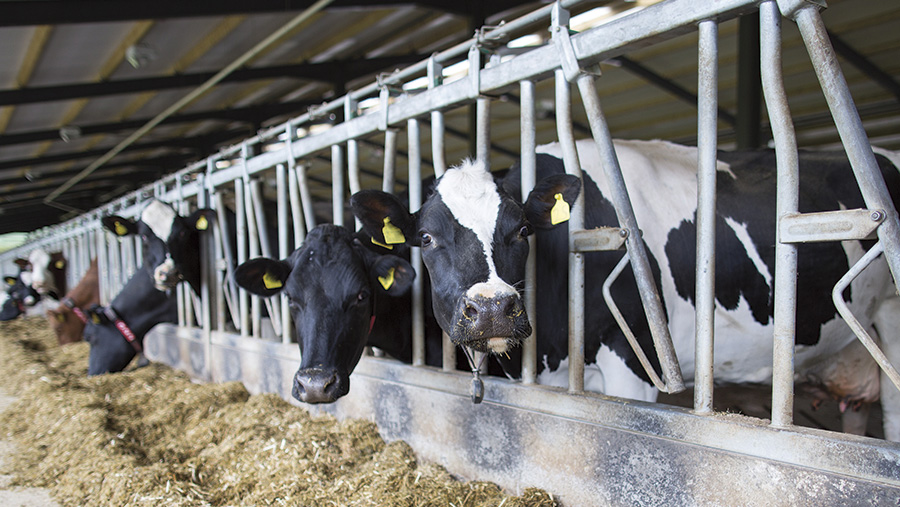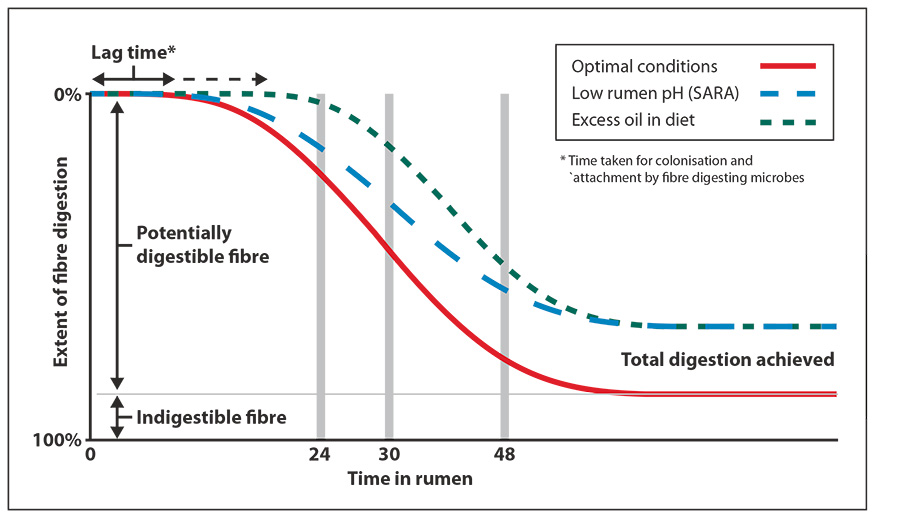Advice on increasing fibre digestion for feed efficiency in cows
 © Geoff Pagotto
© Geoff Pagotto Increasing fibre digestibility could help improve feed efficiency this winter, according to nutritionists.
Fibre is an important component in ruminant diets, both as an energy source and for correct rumen function.
Nicola Walker, AB Vista’s ruminant product development manager, says even small improvements in fibre digestion can significantly increase the amount of milk produced from all feeds, not just forage.
See also: Read more on winter nutrition
“Because fibre is the slowest-digesting fraction within the diet, both the amount consumed and its digestibility can have a massive effect on overall feed efficiency,” she says.
Total dietary fibre typically accounts for 45-50% of the dry matter (DM) in most dairy rations, yet not all of this fibre can be used by the cow. And just as critically, not all of the potentially digestible fibre actually gets broken down.
“The extent to which fibre is digested in the rumen is determined both by potential digestibility and conditions within the rumen,” Dr Walker says.
“When conditions are ideal, the digestibility of plant cell walls – the main source of fibre in the diet – is typically about 65%.
“But when conditions deteriorate, this digestibility can drop as low as 35%.”
What limits fibre digestion?
Sub-acute ruminal acidosis (Sara), for example, can limit fibre digestion by reducing the activity of fibre-digesting microbes and slowing the rate of digestion (see figure 1, blue line).
A similar effect can result when the lag time before digestion is extended, such as when excess oil in the diet slows microbial attachment and colonisation (see figure 1, green line).

(Source: adapted from USDA-ARS, 2014)
Digestibility can also be limited by higher rumen outflow rates limiting the time available for microbial digestion, whether due to the addition of sodium bicarbonate to correct rumen pH, higher water intakes in hot weather or low-fibre diets that are poorly retained in the rumen.
“Many of the best-value feeds used in ruminant diets – grazed grass, silages, moist feeds – supply the majority of their energy as digestible fibre, but that energy is only available if the fibre is actually digested.
“High levels of fibre digestion also improve the balance of volatile fatty acids [VFA] that forms the primary energy supply to the cow,” explains Dr Walker.
Maximising fibre digestion
Formulating diets to optimise rumen digestion of fibre should therefore be a top priority, she says.
A balanced release of energy in the rumen will reduce the risk of Sara, while rumen conditioners and yeasts can further improve rumen function.
Keeping overall oil and fat content below 5% will help avoid coating fibre in the rumen, and so minimise the lag time before fibre digestion begins.
“Recent research using a Trichoderma reesei-derived fungal extract applied as a fibre treatment prior to feeding has shown even a one-hour reduction in the time it takes for microbial attachment and colonisation of fibre in the rumen can raise total mixed ration [TMR] digestibility [D-value] from 63% to 67%.
“The result was an increase in feed efficiency [1.43 to 1.60], milk yield [+1.3 litres a cow] and milk protein [3.58% to 3.70%].”
